Favorite Board Games for 3-year-olds.
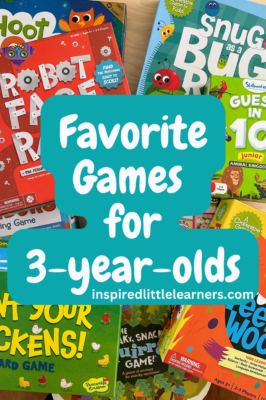
It is hard to believe that my youngest son just turned 3! Three is a fun age to play board games with because they start becoming more familiar with the basic gameplay “rules” (like taking turns, how to roll a dice, spin a spinner and move a game piece). Great games for three-year-olds are made of sturdy materials and involve practicing skills like counting, color learning, and motor skills (among others). I love the learning opportunities that games provide and it’s something that I look for in games for all my kids, along with a game that is fun and engaging and well-designed. My three-year-old is a huge fan of playing games and below is a list of some of our favorite games to play at age 3! Most of these are games that will also be enjoyed by older siblings, as my 6-year-old and 5-year-old still enjoy playing these!
This is my second post in a series of posts that will list favorite games by age!
Use these posts as a loose guideline- just because a board game shows up in a list for one age, doesn’t mean that it can’t be enjoyed by kids of other ages as well!!
Make sure you also check out my post of Favorite Board Games for 2-year-olds!
This post may contain affiliate links. As an Amazon Associate and participant in other affiliate programs, I earn a small commission on qualifying purchases (at no additional cost to you). Thank you for your support! Read our affiliate disclaimer here.
Shopping List by Orchard Toys
If you are looking for a great first game for toddlers, I highly recommend the best-selling game Shopping List by Orchard Toys. This engaging game is made with durable materials and helps kids practice memory, matching, and language skills. Players race to fill their shopping baskets with grocery items on their shopping list. It teaches basic concepts like turn-taking and following instructions while developing vocabulary and memory skills. This game is a memory matching game, but rather than selecting two matching tiles (like a classic memory matching game), you are trying to find items that match an item on your shopping list. I love that this game also encourages vocabulary skills, as you recognize and name the items on your list.
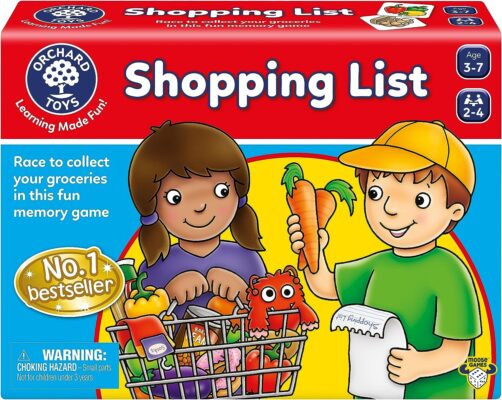
Memory & Matching Game: I Never Forget a Face by eeboo
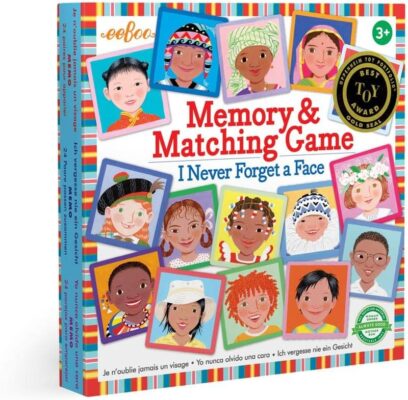
Memory games are great for 3-year-olds, because the basic gameplay is easy to learn and the game is easy to modify and make easier (by removing some pairs from gameplay). Memory matching games are also a classic (it’s one of the earliest games I remember playing as a child) and there are a lot of versions of memory matching games out there! I particularly like Memory & Matching Game: I Never Forget a Face by eeboo, because it introduces children to different cultures and countries. Each child’s home country is identified on the back cover, which can spark an interest in learning more about the countries represented. I also like that the game is durable, which is important when choosing games to play with a toddler!
Hoot Owl Hoot by Peaceable Kingdom
Cooperative games are great for all ages, because they encourage teamwork and positive social relationships as players help one another to reach a common goal. Cooperative games are great for keeping the focus on having fun while playing the game, rather than getting caught up on “winning”. Hoot Owl Hoot! by Peaceable Kingdom is a favorite cooperative game in which players try to help the baby owls fly back to their nest before the sun comes up. You do this by playing a color card and moving an owl to that corresponding color on the game board. The basic game play makes it great for younger kids and you can change the difficulty level of the game from Beginner Level to Challenge Level by playing with different number of owls, which makes this a game that can also be enjoyed by older kids.
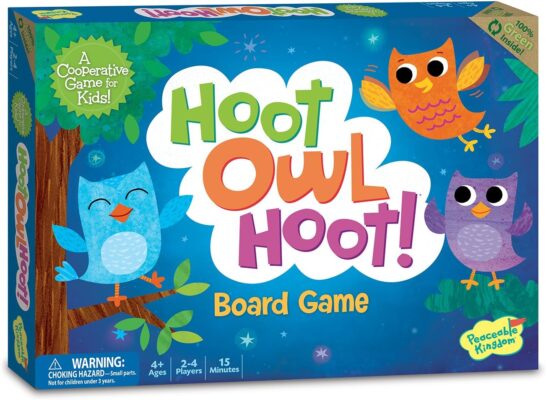
Snug as a Bug in a Rug by Peaceable Kingdom
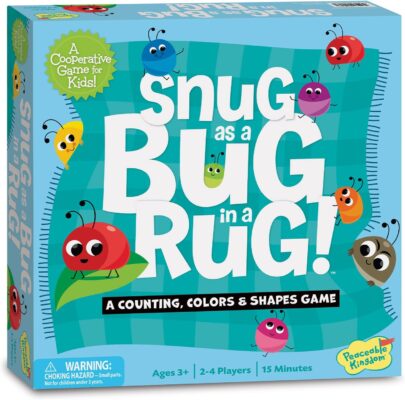
Another cooperative game that we love and is great to start playing around the age of 3 is Snug as a Bug in a Rug by Peaceable Kingdom. In this game, the game board is a cardboard “rug” that is cleverly designed to lay slightly above the tabletop. Players take turns spinning the spinner and work together to tuck all of the bugs under the rug before three stink bugs land on top! I love that with this game, little learners practice important skills like color recognition, counting, identifying shapes and matching. The rules are also easy-to-understand and its a great game for toddlers who are just starting to play board games.
Friends and Neighbors: The Helping Game by Peaceable Kingdom
You may be noticing a pattern, but cooperative games really are a favorite for this age group! And Peaceable Kingdom is the master of making fun cooperative games! I love the cooperative game Friends and Neighbors: The Helping Game by Peaceable Kingdom for this age group, because it is a fun game that helps kids learn about empathy, kindness, and cooperation! Players select a token from the “Helping Bag” and use it to help a neighbor that is on the game board. For example, you may select a token with a bandage, which you can use to help a neighbor that fell and cut their knee. In terms of gameplay, this game is very difficult to “lose”, but there is a lot of value in playing the game- Friends and Neighbors can be used to encourage a child to be empathic and compassionate. As you play the game with your child, you can discuss what emotion the neighbor is expressing (sadness, anger, fear, frustration, etc). The characters can also be used as a conversation starter, by asking your child if they have ever felt that way and when. As the child selects a token from the “Helping Bag”, you can discuss how you can compassionately use that item to help a neighbor. The game also includes a small book that illustrates each resolution that is included in the game. The book illustrates how the neighbor feels after you act compassionately. For example, on one card a child feels frustrated that they are unable to reach a glass of juice. You provide them with a stool and they feel happy that they can now reach!
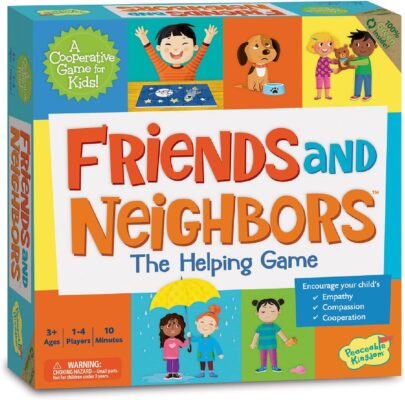
Zingo! by ThinkFun
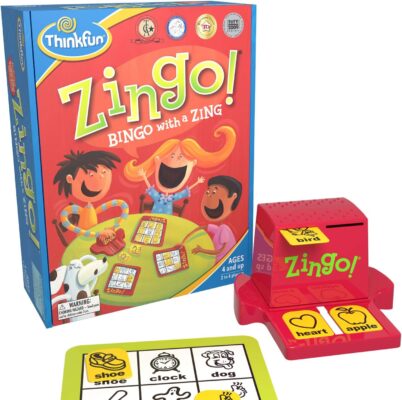
Zingo! Bingo with a Zing by ThinkFun is an exciting twist on the classic game of Bingo. In this interactive game, one player operates the ZINGO! Zinger, which reveals two tiles at a time. When a player sees a tile that matches an image on their card, they take the tile and cover the image. Once a player covers all of the spaces on their card, they shout “ZINGO!” and win the game- this part is a favorite of my kids when we play. When playing with younger kids, I recommend playing at a slower pace or modifying the rules to meet the abilities of the players. This game is designed to help children develop essential skills like matching, vocabulary, and concentration in a fun and entertaining way!
Guess in 10 Junior by Skillmatics
Guess in 10 Junior by Skillmatics was the first game that my oldest two kids learned to play independently together. At the time they were 4-years-old and 3-years-old and watching and listening to them play together was adorable. To play the game, one player selects a card and does not reveal it to the other players. The other players ask up to 10 questions, before guessing what the selected card is. For example, the first player may pick a giraffe card. The other players may ask “Does the animal eat meat?”, “Where does the animal live?”, “Does the animal have four legs?” The players can continue asking up to 10 questions until they have a guess of what is on the selected card. A great feature of Guess in 10 Junior, is that no reading is required, which makes it great for preschool-aged kids. The game even includes Guider Tiles, to help guide the players that are asking questions. For example, a player may pick a Guider Tiles with different foods on it, prompting the player to ask “What does the animal eat?”
We own the “Animal Kingdom” game, but the junior version has other themes available including “Food We Eat” and “Inside My House”. The game materials are also very durable and the game itself if pretty compact, making it an easy game to bring along on a weekend trip!
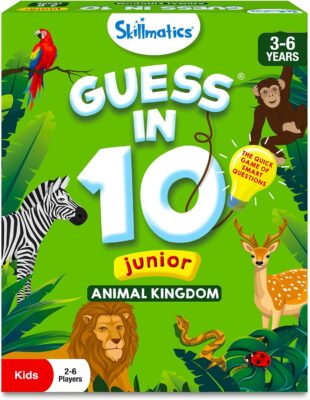
Feed the Woozle by Peaceable Kingdom
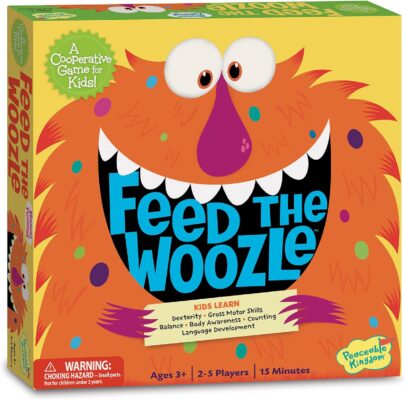
Feed the Woozle is another cooperative game by Peaceable Kingdom. This game is a shining star because it encourages movement, while building concentration and dexterity skills! My kids love this game, because the Woozle loves to eat ridiculous (and sometimes gross) snacks, like “booger chili” and “sand pizza”. The game setup is quick, you just need to set the Woozle up on a table (or other surface) a few feet away from the rest of the game. And the game play is easy to learn: on their turn, a player rolls the die to determine how many snacks they must feed the Woozle. The player then loads that many snacks onto a spoon and must carefully walk them over to the Woozle to feed him! If a snack drops on the floor, the Woozle will not eat it, and those snacks will be lost. As a team, all players must try to feed the Woozle a total of 12 snacks! For slightly older players, there is a spinner with additional challenges – for example, a player may need to walk backwards as they feed the Woozle. When playing with my older kids (6-year-old and 5-year-old), they often complete the additional challenges, while my 3-year-old practices balancing the snacks on the spoon and walking normally. Overall, this is a simple game that doesn’t take long to play, but is guaranteed to get your kids laughing as you read the names of the silly snacks the Woozle eats. Any parent of a 3-year-old can also appreciate a game that gets their kids up and moving to get some wiggles out!
Richard Scarry’s Busy Town Seek and Find Game by Briarpatch
If you have a young child, you know that they LOVE “Seek & Find.” We own many different “Seek & Find” books and these have been a favorite since my kids were around 1 year old. Richard Scarry’s Busy Town Seek and Find Game is a fun and engaging “Seek and Find” game perfect for kids age 3 and up. The game contains a large game board (it’s over 3 feet!) and is a great game to play on the floor or a large table. The game is easy-to-play, with two types of action spaces on the game board: (1) Seek and Find Spaces: if a player lands on this space, every player get a Seek and Find card from the deck and they search the game board for the matching image. The first player to find their item on the board game, rings a bell and gets to keep their card! The first player to collect 5 cards is the winner; however, you can modify this rule to make the game play end sooner (we often play until one player collects 3 cards). (2) Goldbug Spaces are the second type of action space; when a player lands on this space, they draw a Goldbug Card and follow the directions on that card. These cards give opportunities to earn a Seek and Find Card, lose a Seek and Find Card or move forward or backward a space. I love this game because the large game board encourages movement (you often need to get up to look around the entire board for the item on your card), while also developing vocabulary skills, as your child learns the names of different objects pictured. Plus Richard Scarry’s Busytown is a childhood classic, I remember pouring over these books as a child and the colorful illustrations have so many details that keep the interest of kids (and adults)! The game also includes two levels of difficulty, which is great when playing with older kids. To make the game more challenging, you can play with the “Level 2” cards- these Seek and Find cards have two images on them, but only one image is on the game board and the other image is not. Players need to figure to which image IS on the game board and find it!
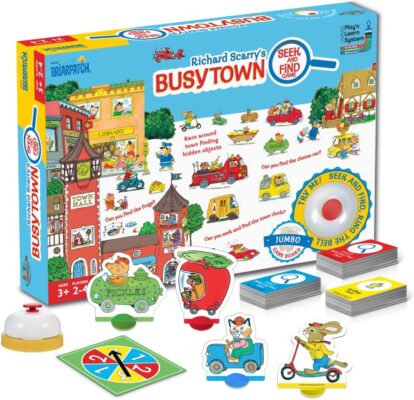
Sneaky Snacky Squirrel by Educational Insights
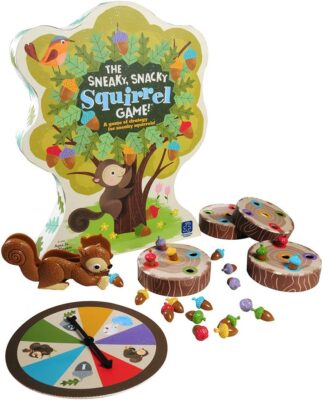
What makes The Sneaky, Snacky Squirrel Game by Educational Insights extra fun for kids is that you use squirrel-shaped tongs to pick up the acorns and add to your log! In general, squeezing tongs is great for building hand and finger strength in young kids and I love that this game incorporates this mechanism into the game play! The rules of the game are simple, which also makes this a great first game to introduce to your child. We introduced it around the age of 2.5 years old; although the game is recommended for 3+ because the acorn pieces are small (so be mindful of this if you have a child who is still mouthing items). To play this game, you spin the spinner and land on a color. Next, you use the squirrel-shaped tongs to pick up an acorn of the corresponding color and place the acorn in the hole with the matching color on your log. Be the first to fill your log with an acorn of each color to win!
Count Your Chickens by Peaceable Kingdom
Another cooperative game by Peaceable Kingdom rounds out the list of favorite games for 3-year-olds! Count Your Chickens is a gentle introduction to counting. In this game, all players work together to help Mother Hen collect her Baby Chicks and put them back in the chicken coop before the Mother Hen reaches the last spot on the gameboard. One thing that I love about this game is that it does not require knowledge of number symbols to play. Young kids can still practice verbal counting using 1:1 correspondence as they move along the game board and move Baby Chicks into the chicken coop. In this game, you spin a spinner and you move the Mother Hen to the corresponding space on the game board. As you move Mother Hen, you count the number of spaces and for each space she moves, you rescue one Baby Chick. If the spinner lands on the Fox, you must take one Baby Chick out of the chicken coop and return it to the farm. Play continues until all Baby Chicks are rescued or until the Mother Hen reaches the chicken coop.
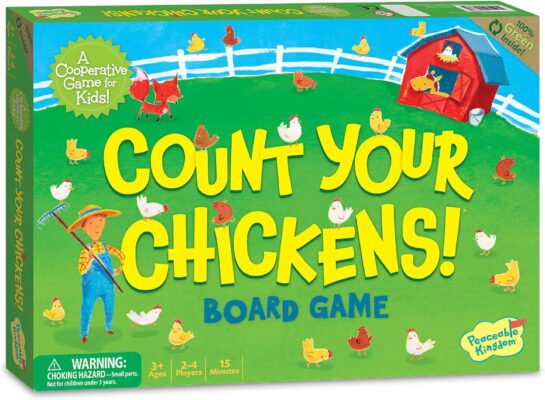
If you are interested in more favorite games by age group, be sure to check out these posts:
Favorite Board Games for 2-year-olds
Favorite Board Games for 4-year-olds
If you are looking for more game recommendations for preschool-age kids, be sure to check out these posts:
Five Preschool Games for Learning Colors
Seven Great Games for Preschoolers
